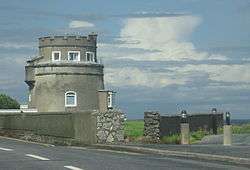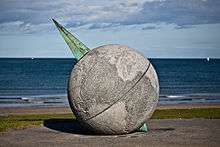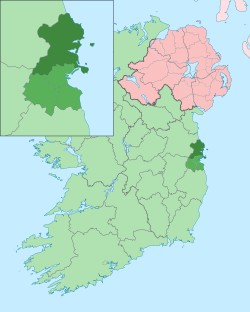Portmarnock
Portmarnock (Irish: Port Mearnóg) is a coastal suburban settlement in Fingal, Ireland, with significant beaches, a modest commercial core and inland residential estates, and two golf courses, including one of Ireland's best-known golf clubs.
Portmarnock Port Mearnóg | |
|---|---|
Suburb (village core) | |
 Martello Tower, Portmarnock | |
 Portmarnock Location in Ireland | |
| Coordinates: 53.4217°N 6.1372°W | |
| Country | Ireland |
| Province | Leinster |
| County | Fingal |
| Local authority | Fingal County Council |
| Elevation | 3 m (10 ft) |
| Population (2011)[1] | |
| • Urban | circa 20,000 |
Portmarnock is also a civil parish in the ancient barony of Coolock in the historic County Dublin.[2] In the 2002 census the population was 8,975 and by 2011 had climbed to 9,285.[3]
Location
Portmarnock lies on the coast between Malahide and Baldoyle. Portmarnock could also be said to border, at sea, Sutton and perhaps Howth in the form of Ireland's Eye. Its major beach, the Velvet Strand, is monitored by a lifeguard during the summer season from early April to the start of October.[4]
Velvet Strand, Portmarnock beach

Adjacent to Portmarnock is a narrow beach which extends onto a sandy peninsula with beaches on all sides. Portmarnock's beach is nicknamed the Velvet Strand due to the smooth sand along the beach, and is popular with wind- and kite-surfers.[5]

The beach was the starting point for two important pioneering flights. On 23 June 1930 Australian aviator Charles Kingsford Smith and his crew took off in the Southern Cross on the second westbound transatlantic flight (to Newfoundland), after which they continued on to Oakland, California, completing a circumnavigation of the world. The first solo westbound transatlantic flight began from Portmarnock beach when Jim Mollison, a British pilot, took off in a de Havilland Puss Moth on 18 August 1932 bound for Pennfield Ridge, New Brunswick, Canada.[6]
The sculpture Eccentric Orbit (by Rachel Joynt and Remco de Fouw, erected 2002) on the seafront is of limestone, bronze and stainless steel. The needle points to the North Star, an age-old navigation point. The sculpture commemorates the epic flights of the Southern Cross (the second non-stop east-west North Atlantic flight, in 1930), the Heart's Content (the first east-west non-stop solo North Atlantic flight, 1932) and the abandoned solo North-Atlantic flight of Faith in Australia (1933).[7]
Portmarnock is home to one of the 29 Napoleonic Martello Towers in the Greater Dublin Area.[8]
Etymology and history
The district's name derives from the Irish word port – meaning "port" – and Saint Marnoch or Mernoc, said[7] to have arrived in what is now Portmarnock in the 5th century AD.
The area had been settled in Neolithic times, as evidenced by flints and other tools excavated on the northern fringe of Portmarnock and the remains of a ring fort visible from the air at the south of the town. The son of Queen Maedhbh of Connaught – Maine – is also said to have been buried locally.
Transport
Portmarnock is on the northern commuter railway line out of Dublin (also the Dublin–Belfast line); Portmarnock railway station, opened on 25 May 1844,[9] is now on the DART network.[10] The village is served by Dublin Bus routes 102, 32, 32X, 42, 42N (Nitelink) and 142.[11] Owing to its proximity to Dublin city, it is a form of dormitory village 15 km (9.3 mi) north-northeast of the city centre.
Education
There are two primary schools – St. Marnock's and St. Helen's – and also a secondary school, Portmarnock Community School.[12]
Religion
Portmarnock has a Roman Catholic parish and church.[13]
Sport
Portmarnock is famous for the world-class golf course at Portmarnock Golf Club, which formally opened on 26 December 1894. Occupying much of the sandy peninsula to the south of the village, the club has hosted many golf tournaments, including the 1960 Canada Cup (now known as the World Cup), the 1991 Walker Cup and the Irish Open on many occasions. Another links course, part of the Portmarnock Hotel and Golf Links complex, that opened in the 1990s, was designed by German golfer Bernhard Langer.[14] That golfing hotel is built around St. Marnock's, the former home of a branch of the Jameson distilling family, which had its own private golf course.[15] St. Marnock's was largely built in the late 1890s to the designs of British architect Sir Robert Lorimer.
Naomh Mearnóg is the local Gaelic Athletic Association club.[16]
Other local sports clubs include Portmarnock Tennis Club, Portmarnock A.F.C., AUL Premier A side Seaview Celtic F.C., and the Portmarnock Sport & Leisure Club which encompasses 16 sporting activities, and holds a swimming pool with some public access hours. Portmarnock Pitch & Putt Club was founded in 1958 and moved to its current location in 1961. It has been affiliated to the Pitch and Putt Union of Ireland since its foundation in 1961 and is currently a members-only club with 250 adult and 55 under-16 members.
Representation
Portmarnock lies in the Dublin Fingal[17] Dáil constituency and in the modern administrative county of Fingal.[18] Before 2016 it was in the Dublin North-East constituency.[19]
Notable people
- Eamonn Andrews, the broadcaster, lived in Portmarnock from 1969 to his death in 1987.[20]
- Brian McFadden, musician and former Westlife singer, lived in Portmarnock until 2004, when he emigrated to the UK with his Australian then-fiancée Delta Goodrem.[21]
- International footballer Stephen Ward grew up in Portmarnock.
References
- "Portmarnock Settlement Results". Central Statistics Office. 2011.
- Placenames Database of Ireland - Portmarnock civil parish, logainm.ie; accessed 11 March 2017.
- "2011 Census Results: Population Classified by Area (Formerly Volume One)" (PDF). 2011 Census. Central Statistics Office (Ireland). 26 April 2012. p. 19. Retrieved 13 March 2017.
- "Velvet Strand (Portmarnock), Co. Dublin". www.blueflagireland.org. Retrieved 7 February 2017.
- "Portmarnock - The Velvet Strand Blue Flag Beach & Green Coast Award 2016". www.visitdublin.com. Retrieved 7 February 2017.
- "Mollison's Atlantic Flight". Flight. 26 August 1932. p. 795. Retrieved 11 July 2018.
- "Portmarnock Community Association".
- Burns, Veronica. "PORTMARNOCK MARTELLO TOWER".
- "Portmarnock station" (PDF). Railscot – Irish Railways. Retrieved 3 September 2007.
- See rail transport in Ireland for more.
- "Timetables - Dublin Bus".
- "Portmarnock Community School - Pobal Scoil Phortmearnóg".
- "Saint Anne's Parish Portmarnock". Retrieved 7 February 2017.
- "Golf Breaks Dublin - Golf Resorts in Ireland - Portmarnock Hotel & Golf Links Dublin".
- "History".
- "Naomh Mearnóg".
- "Electoral (Amendment) (Dáil Constituencies) Act 2013, Schedule".
- "Interactive Map of Fingal". Fingal County Council. Retrieved 11 July 2018.
- "Constituencies of Ireland, 2016 -".
- "TV star Eamonn Andrews loved Portmarnock home - Independent.ie".
- "Brian McFadden: Meeting Vogue was a real life changer... we make each other laugh". Belfast Telegraph. 2 April 2015. Retrieved 11 July 2018.
External links
| Wikimedia Commons has media related to Portmarnock. |
